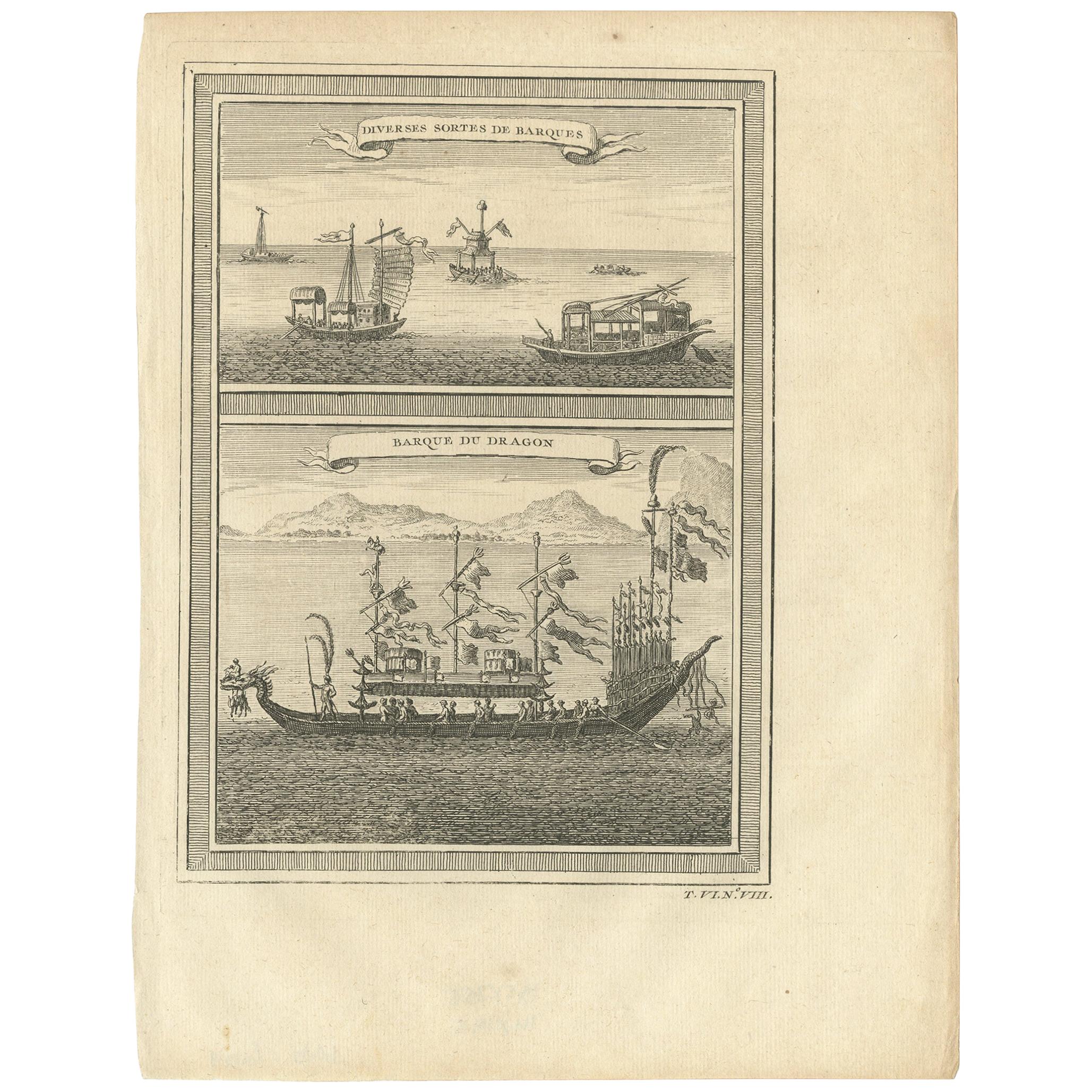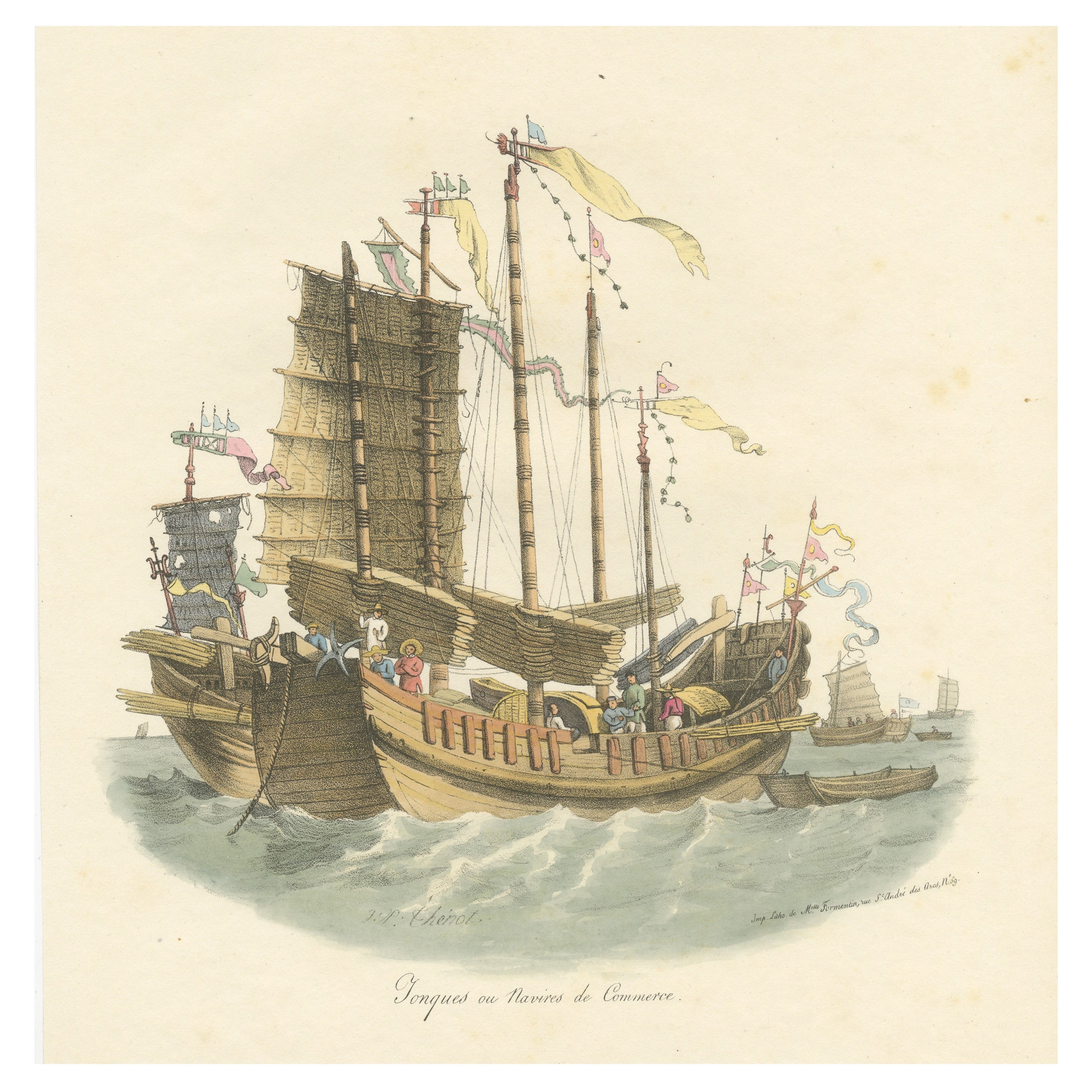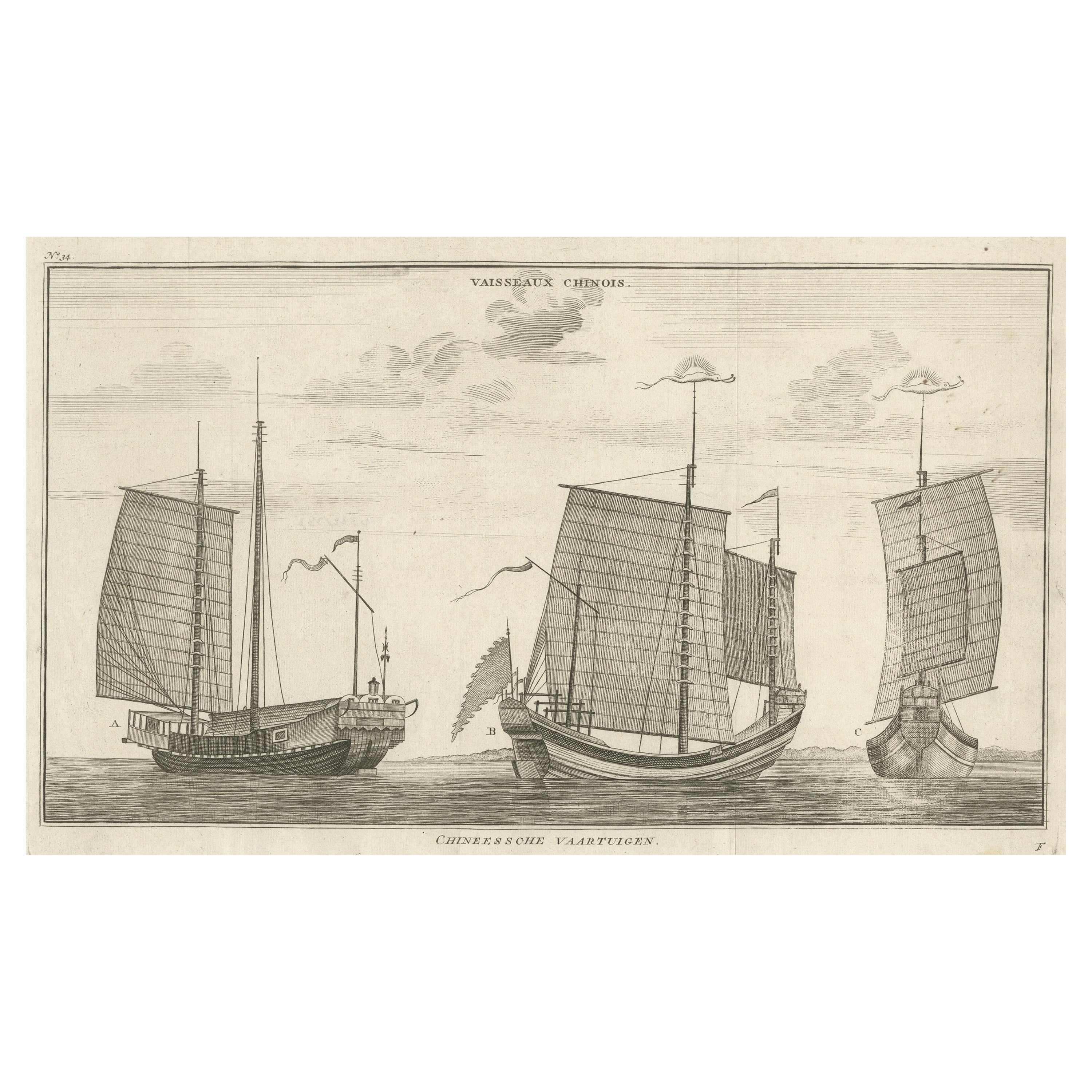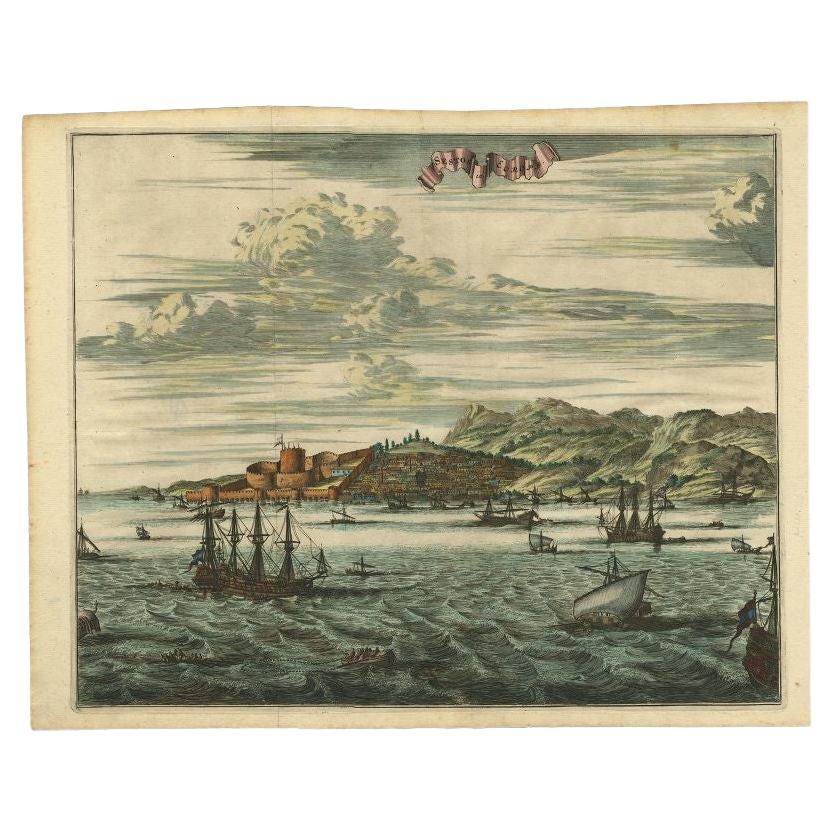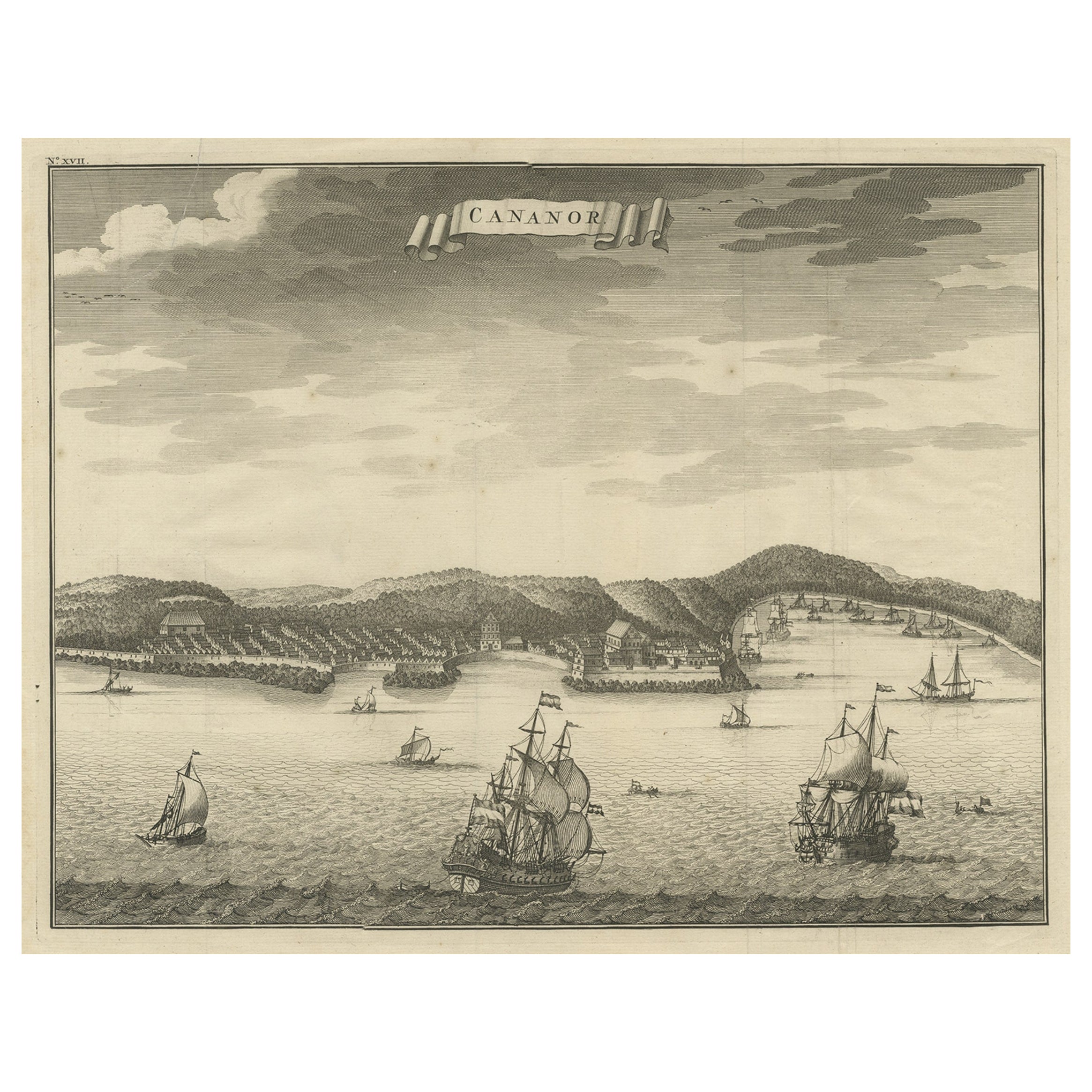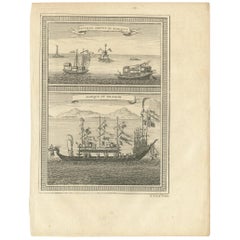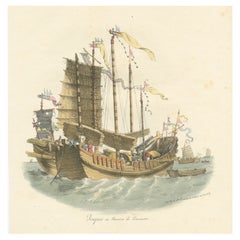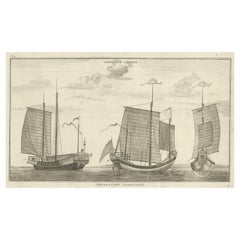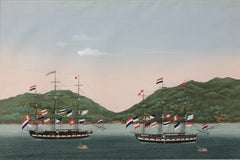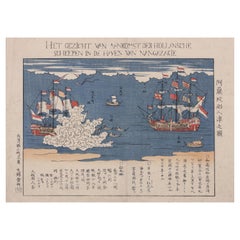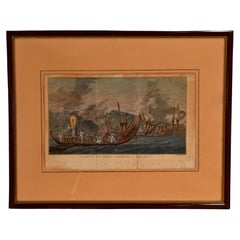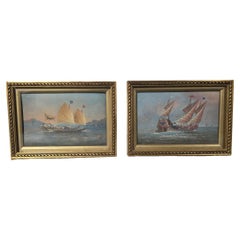Items Similar to Ceremonial Japanese Ships on River – Hand-Colored Print from 18th Century
Want more images or videos?
Request additional images or videos from the seller
1 of 10
Ceremonial Japanese Ships on River – Hand-Colored Print from 18th Century
$114.33
$142.9120% Off
£85.13
£106.4220% Off
€96
€12020% Off
CA$156.61
CA$195.7620% Off
A$174.64
A$218.3020% Off
CHF 91.12
CHF 113.9020% Off
MX$2,142.87
MX$2,678.5920% Off
NOK 1,159.80
NOK 1,449.7420% Off
SEK 1,098.88
SEK 1,373.6020% Off
DKK 730.81
DKK 913.5220% Off
Shipping
Retrieving quote...The 1stDibs Promise:
Authenticity Guarantee,
Money-Back Guarantee,
24-Hour Cancellation
About the Item
Boats in this engraving are intended to represent Japanese ships, particularly ceremonial or diplomatic vessels from the Edo period—but as interpreted by European artists of the late 18th century. Here's why that interpretation holds weight:
Visual Clues Supporting a Japanese Context:
1. Ornamentation and structure:
The boats in the lower scene especially feature highly decorative canopies, banners, and curved prows, which resemble Japanese yakatabune (pleasure barges) or ships used in formal processions.
2. Flags and symbols:
While the flags are stylized, the one with what appears to be a mon (crest) flanked by floral or sunburst motifs could be a Westernized take on a daimyō or shogunate crest. The European artists often approximated these without total accuracy.
3. Landscape elements:
The hilly, lush terrain with closely clustered buildings beside water could resemble Japanese river towns or even views around inland seas like the Seto Inland Sea (Setonaikai), though again, this is likely filtered through a European lens.
4. Historical context:
European publications of the late 18th century, especially encyclopedic works like Bertuch’s *Bilderbuch für Kinder*, frequently included exoticized or romanticized depictions of Asian cultures, especially Japan, which was still very mysterious to many Europeans due to its closed borders during the Edo period (sakoku). Artists often worked from travelers’ accounts, maps, and second-hand sketches.
Why it may not be accurate but still Japanese-inspired:
- The costumes and faces of the figures on the boat look distinctly European, which might reflect either:
- European delegates visiting Japan (like the Dutch VOC envoys to Dejima), or
- Artistic license by a European illustrator unfamiliar with accurate Japanese attire.
- The flags and decorations are hybrid in style—some elements resemble European heraldry, while others have a hint of Asian symbolism. That blending was very common in Enlightenment-era didactic illustrations.
Conclusion:
This engraving depicts Japanese ships—or a European fantasy of Japanese ceremonial boats—as seen from a late 18th-century European perspective. This interpretation fits perfectly with the goals of Bertuch’s Bilderbuch für Kinder, which sought to visually educate European children about the wider world, often through imaginative renderings.
- Dimensions:Height: 9.45 in (24 cm)Width: 7.68 in (19.5 cm)Depth: 0.01 in (0.2 mm)
- Materials and Techniques:Paper,Engraved
- Period:1790-1799
- Date of Manufacture:Circa 1790
- Condition:Fair condition with vibrant hand-coloring. Minor age toning at margins, slight edge wear from prior binding. No major tears or stains. A well-preserved original engraving from the late 18th to early 19th century.
- Seller Location:Langweer, NL
- Reference Number:Seller: BG-043411stDibs: LU3054344553122
About the Seller
5.0
Recognized Seller
These prestigious sellers are industry leaders and represent the highest echelon for item quality and design.
Platinum Seller
Premium sellers with a 4.7+ rating and 24-hour response times
Established in 2009
1stDibs seller since 2017
2,490 sales on 1stDibs
Typical response time: <1 hour
- ShippingRetrieving quote...Shipping from: Langweer, Netherlands
- Return Policy
Authenticity Guarantee
In the unlikely event there’s an issue with an item’s authenticity, contact us within 1 year for a full refund. DetailsMoney-Back Guarantee
If your item is not as described, is damaged in transit, or does not arrive, contact us within 7 days for a full refund. Details24-Hour Cancellation
You have a 24-hour grace period in which to reconsider your purchase, with no questions asked.Vetted Professional Sellers
Our world-class sellers must adhere to strict standards for service and quality, maintaining the integrity of our listings.Price-Match Guarantee
If you find that a seller listed the same item for a lower price elsewhere, we’ll match it.Trusted Global Delivery
Our best-in-class carrier network provides specialized shipping options worldwide, including custom delivery.More From This Seller
View AllAntique Print of Chinese Vessels, 1748
Located in Langweer, NL
Antique print titled 'Diverses Sortes de Barques - Barque du Dragon'. View of Chinese vessels. The top view depicts various types of Chinese barque, including a small vessel at centre that is topped with a high canopy with a shrine on its roof and a pair of large flags...
Category
Antique Mid-18th Century Prints
Materials
Paper
$95 Sale Price
20% Off
Antique Print of Chinese Junks or Merchant Ships, 1827
Located in Langweer, NL
Antique print titled 'Jonques ou Navires de Commerce'. Original old print of Chinese junks or merchant ships. This print originates from 'La Chine, moeurs, usages, costumes, arts et ...
Category
Antique Mid-19th Century Prints
Materials
Paper
$190 Sale Price
20% Off
Antique Original Engraving of Chinese Vessels in the 18th Century, 1765
Located in Langweer, NL
Description: Plate no.34: 'Vaisseaux chinois.' (Chinese vessels.) This original auhentic plate originates from: 'Reize rondom de werreld, Gedaan in de jaaren 1740 tot 1744, door den ...
Category
Antique 1760s Prints
Materials
Paper
$266 Sale Price
20% Off
The Dardanelles in the Age of Sail: A Panoramic Etching, Ca.1765
Located in Langweer, NL
This rare and exquisite view depicts the strategic Dardanelles strait, the narrow passage between the Aegean and the Sea of Marmara with the distant cityscape of Istanbul. Part of th...
Category
Antique 1760s Prints
Materials
Paper
$1,143 Sale Price
20% Off
Free Shipping
Antique Print of Sestos in Turkey with Ships , circa 1680
Located in Langweer, NL
Antique print titled 'Sestos in Europa'. Original antique print showing a view of Sestos, Turkey with ships. This print originates from 'Naukeurige Beschryving der Eilanden in de Arc...
Category
Antique 17th Century Prints
Materials
Paper
$495 Sale Price
20% Off
Antique Print of Kannur or Cananore with Ships, in Kerala, India, 1726
Located in Langweer, NL
Antique print India titled: 'Cananor'. Old print of a view of Kannur (or Cannanore), Kerala, India. From the monumental 'Oud en Nieuw Oost-Indiën ...
Category
Antique 18th Century Prints
Materials
Paper
$362 Sale Price
20% Off
You May Also Like
'Two Dutch Ships Anchored in the Bay of Nagasaki' by Kawahara Keiga '1786-1860'
Located in Amsterdam, NL
Kawahara Keiga (1786 - c. 1860)
Two Dutch ships anchored in the bay of Nagasaki
Sumi ink and pigment on silk, H. 27 x W. 41 cm (excl. frame)
Comes framed, see image.
?Based o...
Category
Antique Early 19th Century Japanese Paintings and Screens
Materials
Silk
$101,230
Free Shipping
A Japanese Nagasaki-e print depicting the arrival of Dutch ships in Nagasaki
Located in Amsterdam, NL
Published by Bunkindõ han, circa 1801
Colour woodblock print, H. 32.5 x W. 48 cm
Under this view of Nagasaki Bay, the text states that the first Dutch ships arrived in Nagasaki in ...
Category
Antique 18th Century Japanese Prints
Materials
Paper
Flotte d'Otahiti Assembled at Oparee, Colored Engraving, Robert Benard, 1778
By Robert Benard
Located in Madrid, ES
Flotte d'Otahiti assembled at Oparee. Colored engraving. Robert Benard (active 1750-1785), 1778.
Hand-colored engraving from the series “The Voyages of Captain Cook”, which makes n...
Category
Antique 1770s European Neoclassical Prints
Materials
Other
Pair of Watercolors of Chinese Boats – 19th Century
Located in Madrid, ES
Charming pair of watercolors depicting traditional Chinese junks at sea. These meticulously detailed 19th-century marine scenes depict typical Far Eastern sailing vessels, in a peace...
Category
Antique 19th Century Chinese Other Paintings
Materials
Paper
18th Century Balthasar Frederich Lazelt Colored Engraving Print
Located in Kingston, NY
18th-century view of Lower Manhattan Harbor New York Entrance by Balthasar Frederic Lazelt colored engraving of New York's original harbor landings filled with ships and commerce, 17...
Category
Antique 18th Century Prints
Materials
Paper
Unpei Kameyama, 'a View of Black 'American' Ships in the Bay of Uraga Senminato'
Located in Amsterdam, NL
Unpei Kameyama (1821-1899)
A view of black (American) ships in the bay of Uraga Senminato, Miura district, June 1853
The Japanese text reads: ‘The seventy-six old men for the Kitamura-clan, drawn in 1897 on request of Yoshisada Kitamura, Himeji, the black ships which so much changed the fate of Japan, enjoy please this masterpiece by Harima Shonin Bisei who brings back memories of his young days.’
Watercolour on paper, laid down on cardboard, H. 44.5 x W. 115.5 cm
Provenance:
Collection of Yoshisada Kitamura, Himeji
Yoshisada Kitamura (1838-1899), the son of a farmer in the village of Ogawa, in the district of Harimakashikihigashi, studied under Matajiro Otaka and got heavily involved in the anti-Shogunate movement. He was active in several military incidents against the Shogunate. After the Meiji restoration, he served the Meiji government as a local official in the Himeji domain.
Kameyama Unpei was a Confucian scholar, a Shinto priest...
Category
Antique Mid-19th Century Japanese Edo Paintings and Screens
Materials
Paper
More Ways To Browse
Japanese Ship
Japanese Flag
Boat Prow
Antique Lunettes
Antique Medical Cabinets
Antique Mortise Lock
Antique Norwegian Cabinet
Antique Pantry Box
Antique Pot Belly
Antique Sandalwood Box
Antique Seafoam Green
Antique Secretary Desk With Display
Antique Sink Vanity
Antique Spindle Beds
Antique Staffordshire Lions
Antique Strong Box Antiques
Antique Swatow Porcelain
Antique Swedish Horse
